Starbucks: Global Business and Strategy Analysis, Course Report
VerifiedAdded on 2021/12/27
|14
|3685
|42
Report
AI Summary
This report provides a comprehensive analysis of Starbucks' global business strategy, examining its background, mission, and workforce. It delves into internal and external analyses using the McKinsey 7s model and Porter's Five Forces, respectively. The report identifies Starbucks' competitive advantages through SWOT analysis, Porter's generic strategies, and VRIO framework, while also analyzing its core competencies and value chain. Strategic recommendations are offered based on Ansoff's matrix, the strategy clock, and expansion and innovation strategies. The analysis highlights Starbucks' differentiation strategy, its emphasis on product quality and customer experience, and its efforts in internationalization. The report concludes with an overview of Starbucks' competitive environment and strategic positioning in the global market.
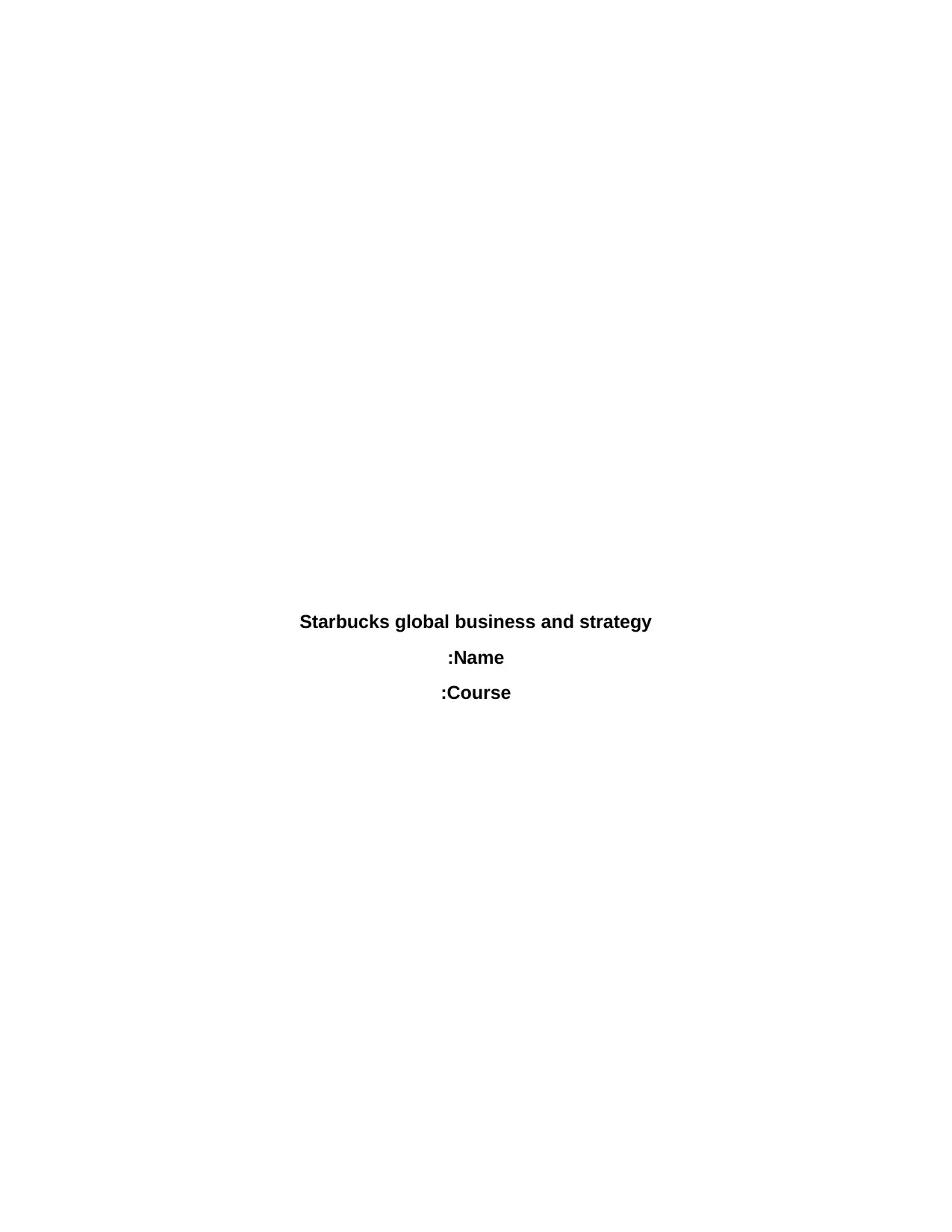
Starbucks global business and strategy
Name:
Course:
Name:
Course:
Paraphrase This Document
Need a fresh take? Get an instant paraphrase of this document with our AI Paraphraser
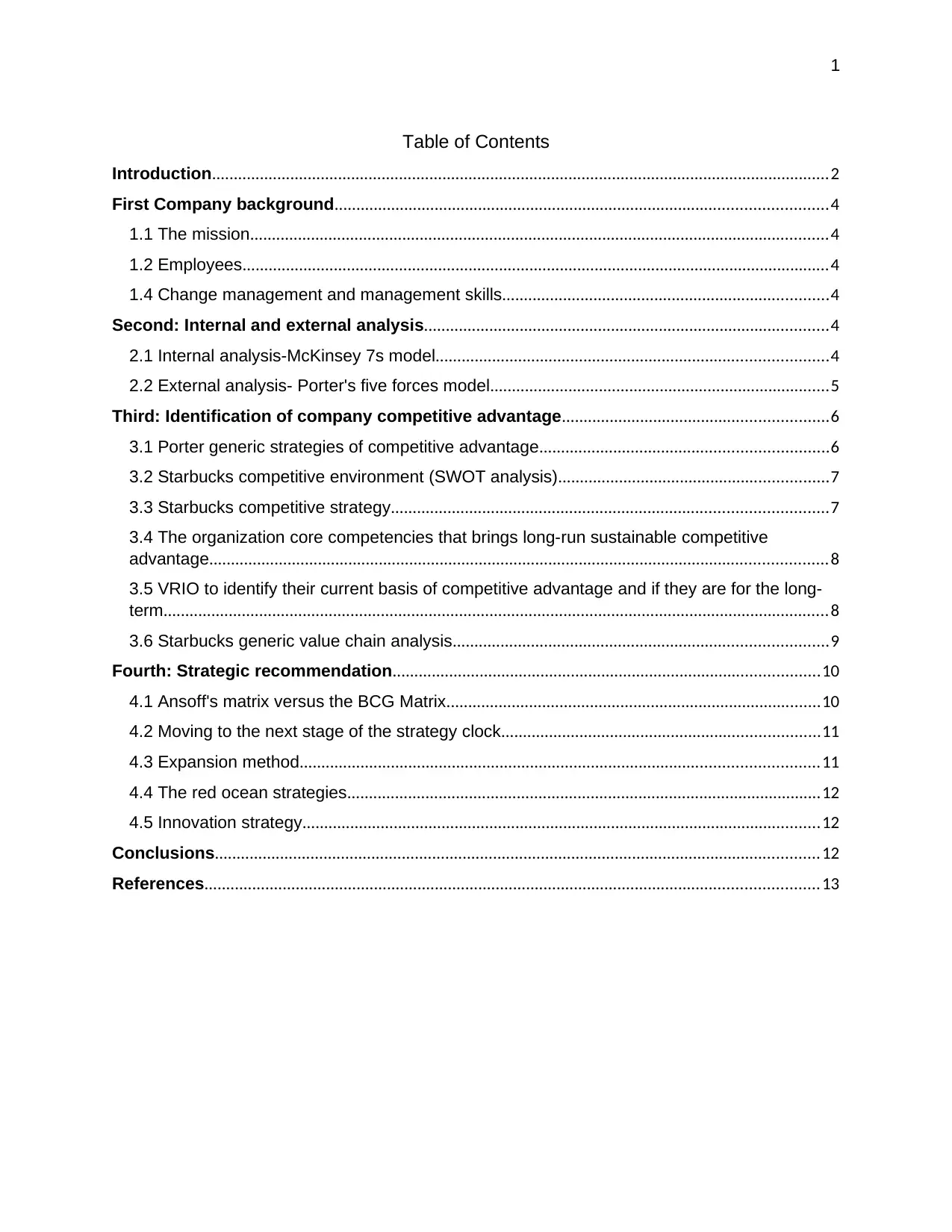
1
Table of Contents
Introduction..............................................................................................................................................2
First Company background.................................................................................................................4
1.1 The mission.....................................................................................................................................4
1.2 Employees.......................................................................................................................................4
1.4 Change management and management skills...........................................................................4
Second: Internal and external analysis.............................................................................................4
2.1 Internal analysis-McKinsey 7s model..........................................................................................4
2.2 External analysis- Porter's five forces model..............................................................................5
Third: Identification of company competitive advantage.............................................................6
3.1 Porter generic strategies of competitive advantage..................................................................6
3.2 Starbucks competitive environment (SWOT analysis)..............................................................7
3.3 Starbucks competitive strategy....................................................................................................7
3.4 The organization core competencies that brings long-run sustainable competitive
advantage..............................................................................................................................................8
3.5 VRIO to identify their current basis of competitive advantage and if they are for the long-
term.........................................................................................................................................................8
3.6 Starbucks generic value chain analysis......................................................................................9
Fourth: Strategic recommendation..................................................................................................10
4.1 Ansoff's matrix versus the BCG Matrix......................................................................................10
4.2 Moving to the next stage of the strategy clock.........................................................................11
4.3 Expansion method.......................................................................................................................11
4.4 The red ocean strategies.............................................................................................................12
4.5 Innovation strategy.......................................................................................................................12
Conclusions...........................................................................................................................................12
References.............................................................................................................................................13
Table of Contents
Introduction..............................................................................................................................................2
First Company background.................................................................................................................4
1.1 The mission.....................................................................................................................................4
1.2 Employees.......................................................................................................................................4
1.4 Change management and management skills...........................................................................4
Second: Internal and external analysis.............................................................................................4
2.1 Internal analysis-McKinsey 7s model..........................................................................................4
2.2 External analysis- Porter's five forces model..............................................................................5
Third: Identification of company competitive advantage.............................................................6
3.1 Porter generic strategies of competitive advantage..................................................................6
3.2 Starbucks competitive environment (SWOT analysis)..............................................................7
3.3 Starbucks competitive strategy....................................................................................................7
3.4 The organization core competencies that brings long-run sustainable competitive
advantage..............................................................................................................................................8
3.5 VRIO to identify their current basis of competitive advantage and if they are for the long-
term.........................................................................................................................................................8
3.6 Starbucks generic value chain analysis......................................................................................9
Fourth: Strategic recommendation..................................................................................................10
4.1 Ansoff's matrix versus the BCG Matrix......................................................................................10
4.2 Moving to the next stage of the strategy clock.........................................................................11
4.3 Expansion method.......................................................................................................................11
4.4 The red ocean strategies.............................................................................................................12
4.5 Innovation strategy.......................................................................................................................12
Conclusions...........................................................................................................................................12
References.............................................................................................................................................13
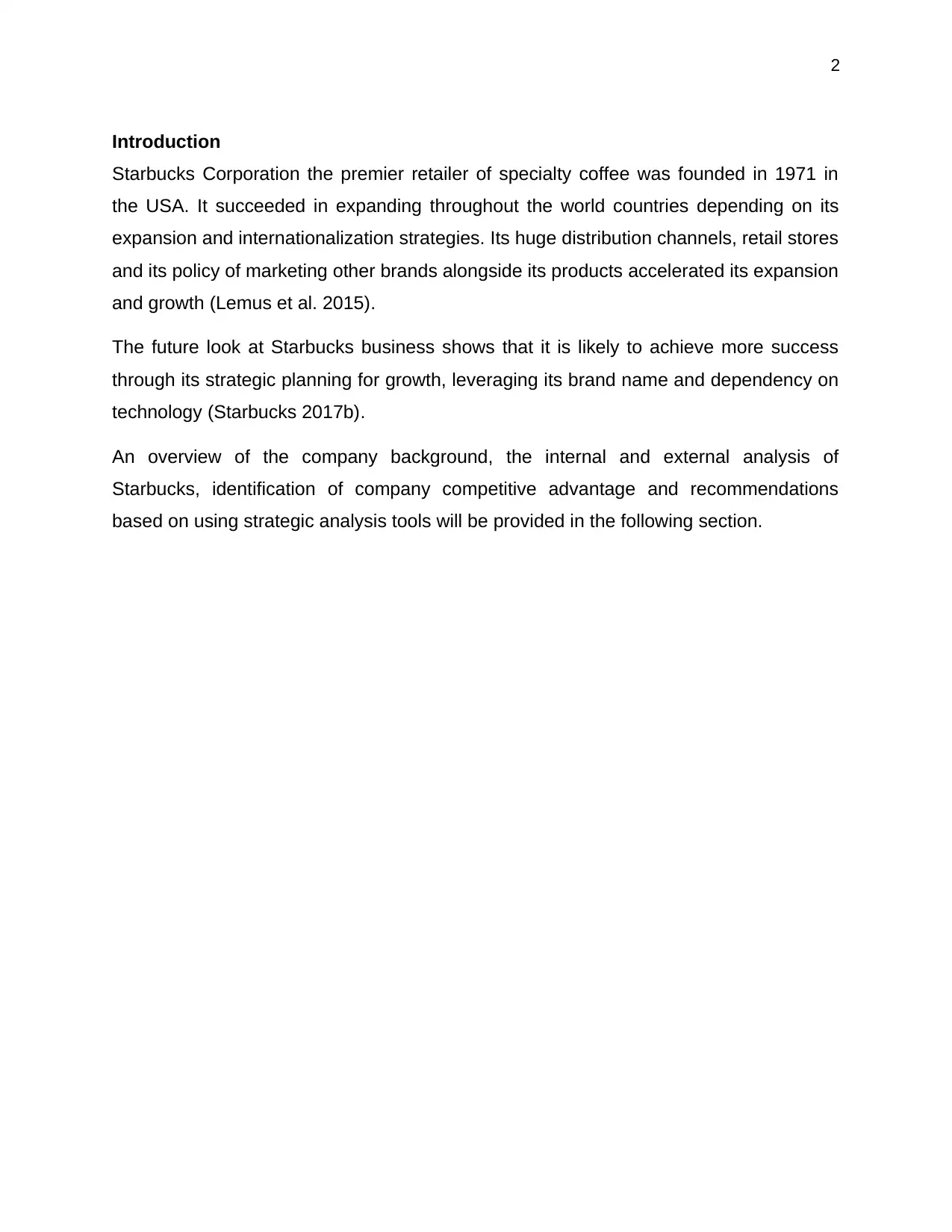
2
Introduction
Starbucks Corporation the premier retailer of specialty coffee was founded in 1971 in
the USA. It succeeded in expanding throughout the world countries depending on its
expansion and internationalization strategies. Its huge distribution channels, retail stores
and its policy of marketing other brands alongside its products accelerated its expansion
and growth (Lemus et al. 2015).
The future look at Starbucks business shows that it is likely to achieve more success
through its strategic planning for growth, leveraging its brand name and dependency on
technology (Starbucks 2017b).
An overview of the company background, the internal and external analysis of
Starbucks, identification of company competitive advantage and recommendations
based on using strategic analysis tools will be provided in the following section.
Introduction
Starbucks Corporation the premier retailer of specialty coffee was founded in 1971 in
the USA. It succeeded in expanding throughout the world countries depending on its
expansion and internationalization strategies. Its huge distribution channels, retail stores
and its policy of marketing other brands alongside its products accelerated its expansion
and growth (Lemus et al. 2015).
The future look at Starbucks business shows that it is likely to achieve more success
through its strategic planning for growth, leveraging its brand name and dependency on
technology (Starbucks 2017b).
An overview of the company background, the internal and external analysis of
Starbucks, identification of company competitive advantage and recommendations
based on using strategic analysis tools will be provided in the following section.
⊘ This is a preview!⊘
Do you want full access?
Subscribe today to unlock all pages.

Trusted by 1+ million students worldwide
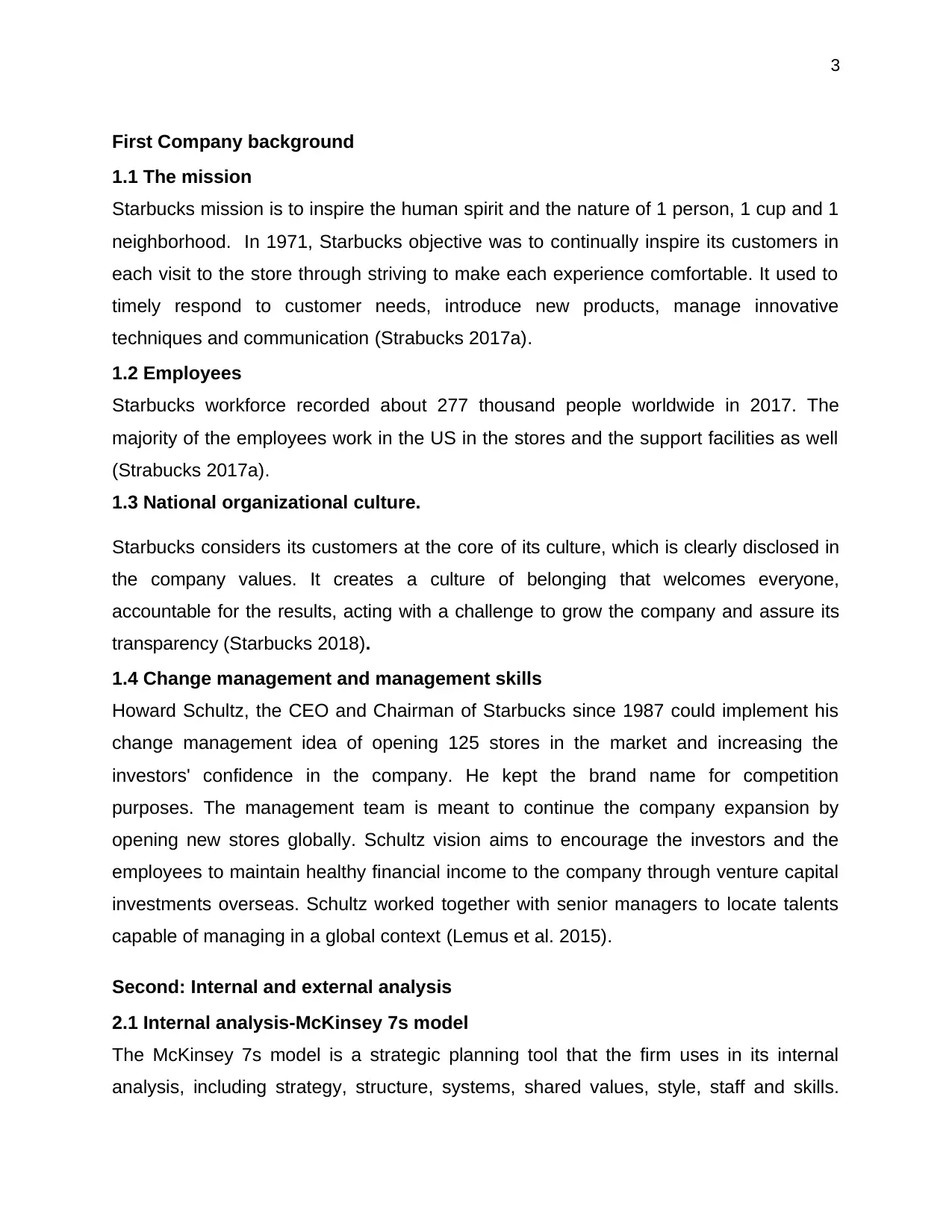
3
First Company background
1.1 The mission
Starbucks mission is to inspire the human spirit and the nature of 1 person, 1 cup and 1
neighborhood. In 1971, Starbucks objective was to continually inspire its customers in
each visit to the store through striving to make each experience comfortable. It used to
timely respond to customer needs, introduce new products, manage innovative
techniques and communication (Strabucks 2017a).
1.2 Employees
Starbucks workforce recorded about 277 thousand people worldwide in 2017. The
majority of the employees work in the US in the stores and the support facilities as well
(Strabucks 2017a).
1.3 National organizational culture.
Starbucks considers its customers at the core of its culture, which is clearly disclosed in
the company values. It creates a culture of belonging that welcomes everyone,
accountable for the results, acting with a challenge to grow the company and assure its
transparency (Starbucks 2018).
1.4 Change management and management skills
Howard Schultz, the CEO and Chairman of Starbucks since 1987 could implement his
change management idea of opening 125 stores in the market and increasing the
investors' confidence in the company. He kept the brand name for competition
purposes. The management team is meant to continue the company expansion by
opening new stores globally. Schultz vision aims to encourage the investors and the
employees to maintain healthy financial income to the company through venture capital
investments overseas. Schultz worked together with senior managers to locate talents
capable of managing in a global context (Lemus et al. 2015).
Second: Internal and external analysis
2.1 Internal analysis-McKinsey 7s model
The McKinsey 7s model is a strategic planning tool that the firm uses in its internal
analysis, including strategy, structure, systems, shared values, style, staff and skills.
First Company background
1.1 The mission
Starbucks mission is to inspire the human spirit and the nature of 1 person, 1 cup and 1
neighborhood. In 1971, Starbucks objective was to continually inspire its customers in
each visit to the store through striving to make each experience comfortable. It used to
timely respond to customer needs, introduce new products, manage innovative
techniques and communication (Strabucks 2017a).
1.2 Employees
Starbucks workforce recorded about 277 thousand people worldwide in 2017. The
majority of the employees work in the US in the stores and the support facilities as well
(Strabucks 2017a).
1.3 National organizational culture.
Starbucks considers its customers at the core of its culture, which is clearly disclosed in
the company values. It creates a culture of belonging that welcomes everyone,
accountable for the results, acting with a challenge to grow the company and assure its
transparency (Starbucks 2018).
1.4 Change management and management skills
Howard Schultz, the CEO and Chairman of Starbucks since 1987 could implement his
change management idea of opening 125 stores in the market and increasing the
investors' confidence in the company. He kept the brand name for competition
purposes. The management team is meant to continue the company expansion by
opening new stores globally. Schultz vision aims to encourage the investors and the
employees to maintain healthy financial income to the company through venture capital
investments overseas. Schultz worked together with senior managers to locate talents
capable of managing in a global context (Lemus et al. 2015).
Second: Internal and external analysis
2.1 Internal analysis-McKinsey 7s model
The McKinsey 7s model is a strategic planning tool that the firm uses in its internal
analysis, including strategy, structure, systems, shared values, style, staff and skills.
Paraphrase This Document
Need a fresh take? Get an instant paraphrase of this document with our AI Paraphraser

4
The alignment of the 7 interconnected elements together enables the organization to
function effectively (Nejad, Behbodi & Ravanfar 2015). The 7s model could be applied
to Starbucks, according to Cadet (2015), as follows:
Shared values: Starbucks promotes for a culture that respects the employees and
maintains equal treatment. Also, it manages diversity and fully engages in
leadership. In addition, it applies the highest standards of excellence through its
value chain and recognizes profitability as the major driver for future success.
Strategy: The CEO strategy aims to highly increase the sales volume by continually
opening new stores.
Structure: Starbucks functional structure is tall and divisional, it involves, marketing,
human resources, public affairs, sales, corporate social responsibility, public affairs
and other departments.
Style and skills: The CEO takes the responsibility for the company failure and
success as well. Also, he is a visionary manager that could implement his vision in
practice and succeed in fulfilling the company's long-term goals.
Staff: Starbucks has a big staff of talented employees worldwide where training and
development takes a significant priority.
System: The operating staff represents the major element in the system function
due to the strength of the training and development. Also, the leadership skills
maintain the operating system to the highest level of effectiveness.
2.2 External analysis- Porter's five forces model
Porters' five forces model involves an analysis of the threat of new entrants, threat of
substitutes, bargaining power of buyers, bargaining power of suppliers and intensity of
competitive rivalry (Tavitiyaman, Qu & Zhang 2011) (Marshall 2013).
Threat of new entrants: It is considered a moderate level because the barriers of
new entrants are not very high to prevent new businesses to enter the soft drink
market. Accordingly, the level of market saturation is moderate, but it is
accompanied by a monopolistic competition structure. The new entrants will need a
moderate level of initial investment. Starbucks enjoys large economies of scale and
scope that creates a competitive advantage for it that facilitates their access to raw
materials of the finest quality of coffee beans.
The alignment of the 7 interconnected elements together enables the organization to
function effectively (Nejad, Behbodi & Ravanfar 2015). The 7s model could be applied
to Starbucks, according to Cadet (2015), as follows:
Shared values: Starbucks promotes for a culture that respects the employees and
maintains equal treatment. Also, it manages diversity and fully engages in
leadership. In addition, it applies the highest standards of excellence through its
value chain and recognizes profitability as the major driver for future success.
Strategy: The CEO strategy aims to highly increase the sales volume by continually
opening new stores.
Structure: Starbucks functional structure is tall and divisional, it involves, marketing,
human resources, public affairs, sales, corporate social responsibility, public affairs
and other departments.
Style and skills: The CEO takes the responsibility for the company failure and
success as well. Also, he is a visionary manager that could implement his vision in
practice and succeed in fulfilling the company's long-term goals.
Staff: Starbucks has a big staff of talented employees worldwide where training and
development takes a significant priority.
System: The operating staff represents the major element in the system function
due to the strength of the training and development. Also, the leadership skills
maintain the operating system to the highest level of effectiveness.
2.2 External analysis- Porter's five forces model
Porters' five forces model involves an analysis of the threat of new entrants, threat of
substitutes, bargaining power of buyers, bargaining power of suppliers and intensity of
competitive rivalry (Tavitiyaman, Qu & Zhang 2011) (Marshall 2013).
Threat of new entrants: It is considered a moderate level because the barriers of
new entrants are not very high to prevent new businesses to enter the soft drink
market. Accordingly, the level of market saturation is moderate, but it is
accompanied by a monopolistic competition structure. The new entrants will need a
moderate level of initial investment. Starbucks enjoys large economies of scale and
scope that creates a competitive advantage for it that facilitates their access to raw
materials of the finest quality of coffee beans.
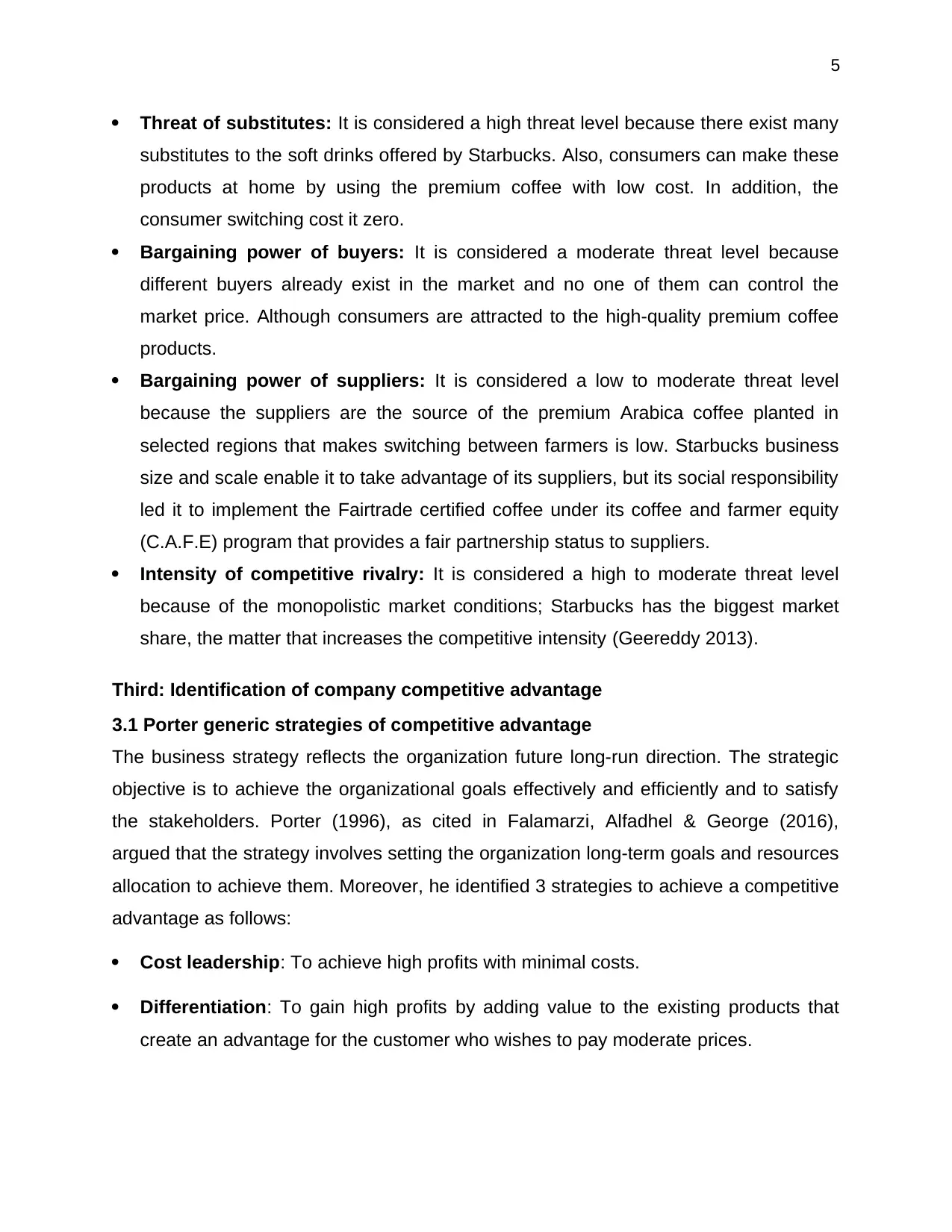
5
Threat of substitutes: It is considered a high threat level because there exist many
substitutes to the soft drinks offered by Starbucks. Also, consumers can make these
products at home by using the premium coffee with low cost. In addition, the
consumer switching cost it zero.
Bargaining power of buyers: It is considered a moderate threat level because
different buyers already exist in the market and no one of them can control the
market price. Although consumers are attracted to the high-quality premium coffee
products.
Bargaining power of suppliers: It is considered a low to moderate threat level
because the suppliers are the source of the premium Arabica coffee planted in
selected regions that makes switching between farmers is low. Starbucks business
size and scale enable it to take advantage of its suppliers, but its social responsibility
led it to implement the Fairtrade certified coffee under its coffee and farmer equity
(C.A.F.E) program that provides a fair partnership status to suppliers.
Intensity of competitive rivalry: It is considered a high to moderate threat level
because of the monopolistic market conditions; Starbucks has the biggest market
share, the matter that increases the competitive intensity (Geereddy 2013).
Third: Identification of company competitive advantage
3.1 Porter generic strategies of competitive advantage
The business strategy reflects the organization future long-run direction. The strategic
objective is to achieve the organizational goals effectively and efficiently and to satisfy
the stakeholders. Porter (1996), as cited in Falamarzi, Alfadhel & George (2016),
argued that the strategy involves setting the organization long-term goals and resources
allocation to achieve them. Moreover, he identified 3 strategies to achieve a competitive
advantage as follows:
Cost leadership: To achieve high profits with minimal costs.
Differentiation: To gain high profits by adding value to the existing products that
create an advantage for the customer who wishes to pay moderate prices.
Threat of substitutes: It is considered a high threat level because there exist many
substitutes to the soft drinks offered by Starbucks. Also, consumers can make these
products at home by using the premium coffee with low cost. In addition, the
consumer switching cost it zero.
Bargaining power of buyers: It is considered a moderate threat level because
different buyers already exist in the market and no one of them can control the
market price. Although consumers are attracted to the high-quality premium coffee
products.
Bargaining power of suppliers: It is considered a low to moderate threat level
because the suppliers are the source of the premium Arabica coffee planted in
selected regions that makes switching between farmers is low. Starbucks business
size and scale enable it to take advantage of its suppliers, but its social responsibility
led it to implement the Fairtrade certified coffee under its coffee and farmer equity
(C.A.F.E) program that provides a fair partnership status to suppliers.
Intensity of competitive rivalry: It is considered a high to moderate threat level
because of the monopolistic market conditions; Starbucks has the biggest market
share, the matter that increases the competitive intensity (Geereddy 2013).
Third: Identification of company competitive advantage
3.1 Porter generic strategies of competitive advantage
The business strategy reflects the organization future long-run direction. The strategic
objective is to achieve the organizational goals effectively and efficiently and to satisfy
the stakeholders. Porter (1996), as cited in Falamarzi, Alfadhel & George (2016),
argued that the strategy involves setting the organization long-term goals and resources
allocation to achieve them. Moreover, he identified 3 strategies to achieve a competitive
advantage as follows:
Cost leadership: To achieve high profits with minimal costs.
Differentiation: To gain high profits by adding value to the existing products that
create an advantage for the customer who wishes to pay moderate prices.
⊘ This is a preview!⊘
Do you want full access?
Subscribe today to unlock all pages.

Trusted by 1+ million students worldwide
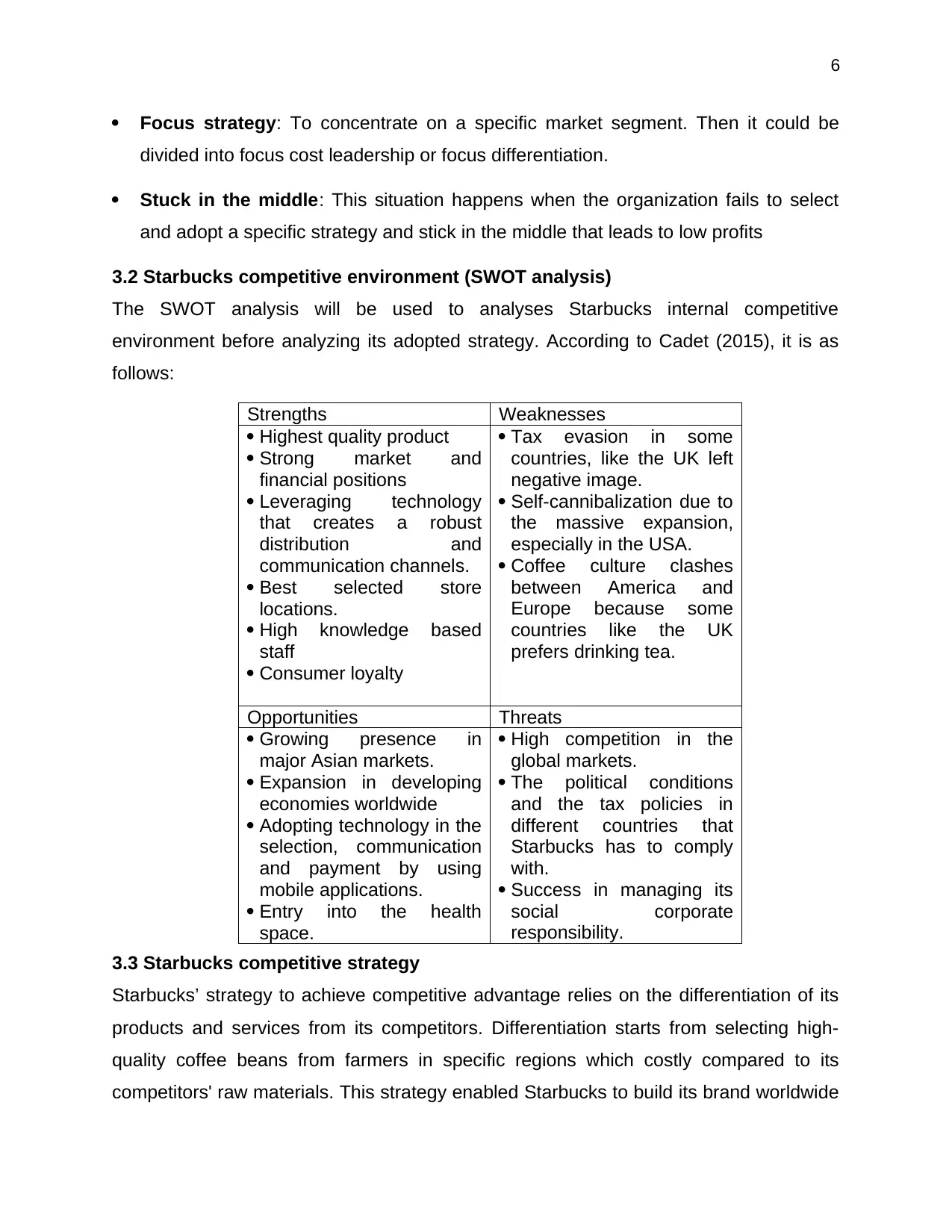
6
Focus strategy: To concentrate on a specific market segment. Then it could be
divided into focus cost leadership or focus differentiation.
Stuck in the middle: This situation happens when the organization fails to select
and adopt a specific strategy and stick in the middle that leads to low profits
3.2 Starbucks competitive environment (SWOT analysis)
The SWOT analysis will be used to analyses Starbucks internal competitive
environment before analyzing its adopted strategy. According to Cadet (2015), it is as
follows:
3.3 Starbucks competitive strategy
Starbucks’ strategy to achieve competitive advantage relies on the differentiation of its
products and services from its competitors. Differentiation starts from selecting high-
quality coffee beans from farmers in specific regions which costly compared to its
competitors' raw materials. This strategy enabled Starbucks to build its brand worldwide
Strengths Weaknesses
Highest quality product
Strong market and
financial positions
Leveraging technology
that creates a robust
distribution and
communication channels.
Best selected store
locations.
High knowledge based
staff
Consumer loyalty
Tax evasion in some
countries, like the UK left
negative image.
Self-cannibalization due to
the massive expansion,
especially in the USA.
Coffee culture clashes
between America and
Europe because some
countries like the UK
prefers drinking tea.
Opportunities Threats
Growing presence in
major Asian markets.
Expansion in developing
economies worldwide
Adopting technology in the
selection, communication
and payment by using
mobile applications.
Entry into the health
space.
High competition in the
global markets.
The political conditions
and the tax policies in
different countries that
Starbucks has to comply
with.
Success in managing its
social corporate
responsibility.
Focus strategy: To concentrate on a specific market segment. Then it could be
divided into focus cost leadership or focus differentiation.
Stuck in the middle: This situation happens when the organization fails to select
and adopt a specific strategy and stick in the middle that leads to low profits
3.2 Starbucks competitive environment (SWOT analysis)
The SWOT analysis will be used to analyses Starbucks internal competitive
environment before analyzing its adopted strategy. According to Cadet (2015), it is as
follows:
3.3 Starbucks competitive strategy
Starbucks’ strategy to achieve competitive advantage relies on the differentiation of its
products and services from its competitors. Differentiation starts from selecting high-
quality coffee beans from farmers in specific regions which costly compared to its
competitors' raw materials. This strategy enabled Starbucks to build its brand worldwide
Strengths Weaknesses
Highest quality product
Strong market and
financial positions
Leveraging technology
that creates a robust
distribution and
communication channels.
Best selected store
locations.
High knowledge based
staff
Consumer loyalty
Tax evasion in some
countries, like the UK left
negative image.
Self-cannibalization due to
the massive expansion,
especially in the USA.
Coffee culture clashes
between America and
Europe because some
countries like the UK
prefers drinking tea.
Opportunities Threats
Growing presence in
major Asian markets.
Expansion in developing
economies worldwide
Adopting technology in the
selection, communication
and payment by using
mobile applications.
Entry into the health
space.
High competition in the
global markets.
The political conditions
and the tax policies in
different countries that
Starbucks has to comply
with.
Success in managing its
social corporate
responsibility.
Paraphrase This Document
Need a fresh take? Get an instant paraphrase of this document with our AI Paraphraser
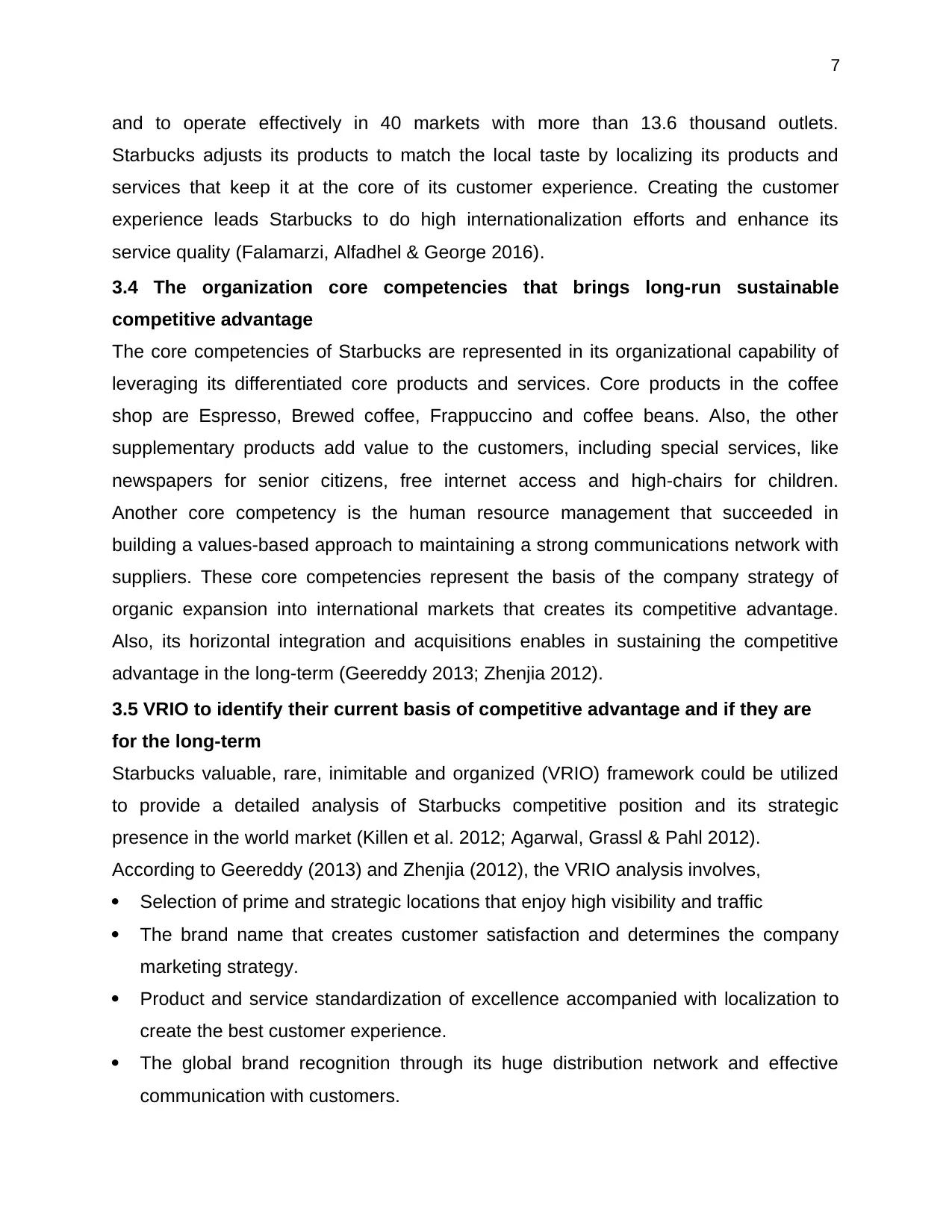
7
and to operate effectively in 40 markets with more than 13.6 thousand outlets.
Starbucks adjusts its products to match the local taste by localizing its products and
services that keep it at the core of its customer experience. Creating the customer
experience leads Starbucks to do high internationalization efforts and enhance its
service quality (Falamarzi, Alfadhel & George 2016).
3.4 The organization core competencies that brings long-run sustainable
competitive advantage
The core competencies of Starbucks are represented in its organizational capability of
leveraging its differentiated core products and services. Core products in the coffee
shop are Espresso, Brewed coffee, Frappuccino and coffee beans. Also, the other
supplementary products add value to the customers, including special services, like
newspapers for senior citizens, free internet access and high-chairs for children.
Another core competency is the human resource management that succeeded in
building a values-based approach to maintaining a strong communications network with
suppliers. These core competencies represent the basis of the company strategy of
organic expansion into international markets that creates its competitive advantage.
Also, its horizontal integration and acquisitions enables in sustaining the competitive
advantage in the long-term (Geereddy 2013; Zhenjia 2012).
3.5 VRIO to identify their current basis of competitive advantage and if they are
for the long-term
Starbucks valuable, rare, inimitable and organized (VRIO) framework could be utilized
to provide a detailed analysis of Starbucks competitive position and its strategic
presence in the world market (Killen et al. 2012; Agarwal, Grassl & Pahl 2012).
According to Geereddy (2013) and Zhenjia (2012), the VRIO analysis involves,
Selection of prime and strategic locations that enjoy high visibility and traffic
The brand name that creates customer satisfaction and determines the company
marketing strategy.
Product and service standardization of excellence accompanied with localization to
create the best customer experience.
The global brand recognition through its huge distribution network and effective
communication with customers.
and to operate effectively in 40 markets with more than 13.6 thousand outlets.
Starbucks adjusts its products to match the local taste by localizing its products and
services that keep it at the core of its customer experience. Creating the customer
experience leads Starbucks to do high internationalization efforts and enhance its
service quality (Falamarzi, Alfadhel & George 2016).
3.4 The organization core competencies that brings long-run sustainable
competitive advantage
The core competencies of Starbucks are represented in its organizational capability of
leveraging its differentiated core products and services. Core products in the coffee
shop are Espresso, Brewed coffee, Frappuccino and coffee beans. Also, the other
supplementary products add value to the customers, including special services, like
newspapers for senior citizens, free internet access and high-chairs for children.
Another core competency is the human resource management that succeeded in
building a values-based approach to maintaining a strong communications network with
suppliers. These core competencies represent the basis of the company strategy of
organic expansion into international markets that creates its competitive advantage.
Also, its horizontal integration and acquisitions enables in sustaining the competitive
advantage in the long-term (Geereddy 2013; Zhenjia 2012).
3.5 VRIO to identify their current basis of competitive advantage and if they are
for the long-term
Starbucks valuable, rare, inimitable and organized (VRIO) framework could be utilized
to provide a detailed analysis of Starbucks competitive position and its strategic
presence in the world market (Killen et al. 2012; Agarwal, Grassl & Pahl 2012).
According to Geereddy (2013) and Zhenjia (2012), the VRIO analysis involves,
Selection of prime and strategic locations that enjoy high visibility and traffic
The brand name that creates customer satisfaction and determines the company
marketing strategy.
Product and service standardization of excellence accompanied with localization to
create the best customer experience.
The global brand recognition through its huge distribution network and effective
communication with customers.
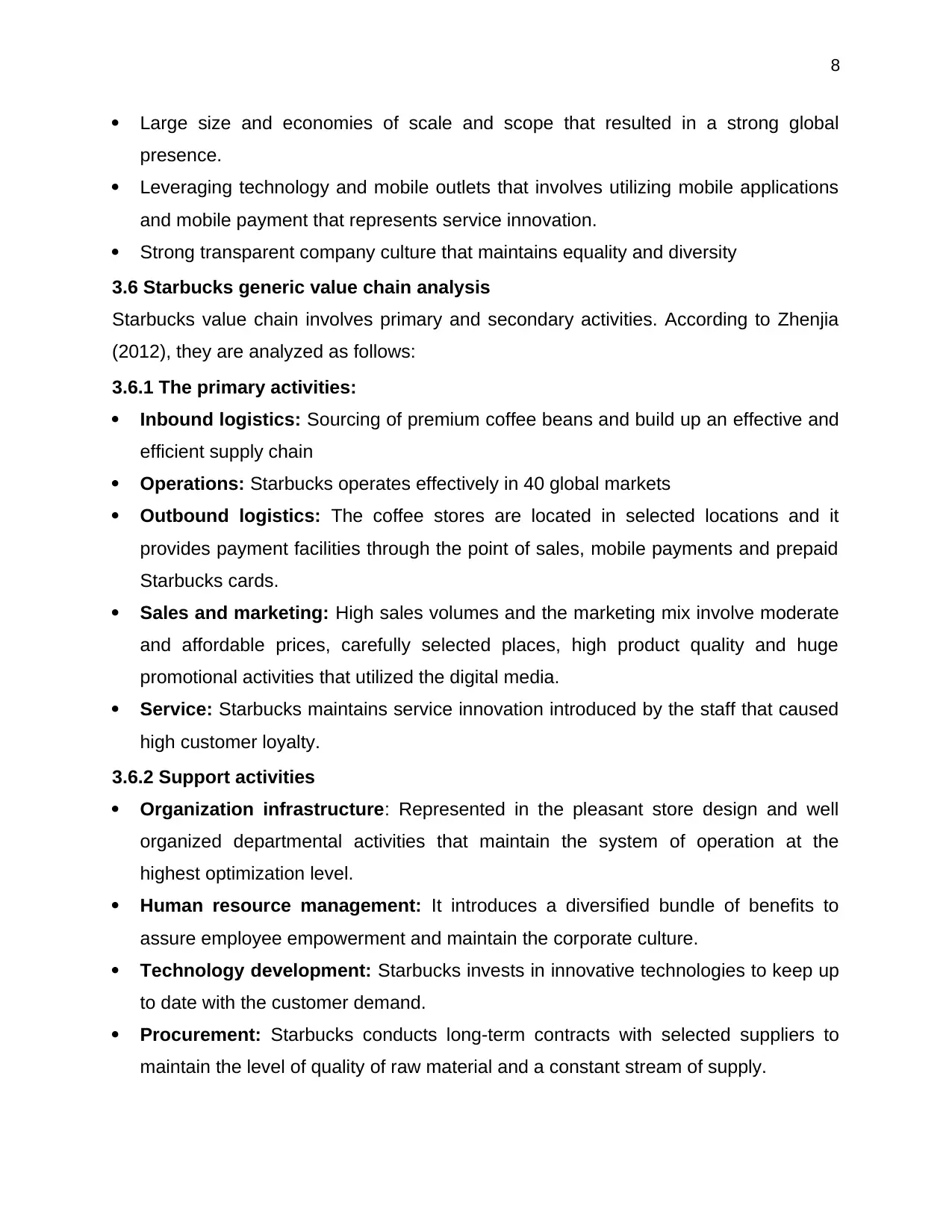
8
Large size and economies of scale and scope that resulted in a strong global
presence.
Leveraging technology and mobile outlets that involves utilizing mobile applications
and mobile payment that represents service innovation.
Strong transparent company culture that maintains equality and diversity
3.6 Starbucks generic value chain analysis
Starbucks value chain involves primary and secondary activities. According to Zhenjia
(2012), they are analyzed as follows:
3.6.1 The primary activities:
Inbound logistics: Sourcing of premium coffee beans and build up an effective and
efficient supply chain
Operations: Starbucks operates effectively in 40 global markets
Outbound logistics: The coffee stores are located in selected locations and it
provides payment facilities through the point of sales, mobile payments and prepaid
Starbucks cards.
Sales and marketing: High sales volumes and the marketing mix involve moderate
and affordable prices, carefully selected places, high product quality and huge
promotional activities that utilized the digital media.
Service: Starbucks maintains service innovation introduced by the staff that caused
high customer loyalty.
3.6.2 Support activities
Organization infrastructure: Represented in the pleasant store design and well
organized departmental activities that maintain the system of operation at the
highest optimization level.
Human resource management: It introduces a diversified bundle of benefits to
assure employee empowerment and maintain the corporate culture.
Technology development: Starbucks invests in innovative technologies to keep up
to date with the customer demand.
Procurement: Starbucks conducts long-term contracts with selected suppliers to
maintain the level of quality of raw material and a constant stream of supply.
Large size and economies of scale and scope that resulted in a strong global
presence.
Leveraging technology and mobile outlets that involves utilizing mobile applications
and mobile payment that represents service innovation.
Strong transparent company culture that maintains equality and diversity
3.6 Starbucks generic value chain analysis
Starbucks value chain involves primary and secondary activities. According to Zhenjia
(2012), they are analyzed as follows:
3.6.1 The primary activities:
Inbound logistics: Sourcing of premium coffee beans and build up an effective and
efficient supply chain
Operations: Starbucks operates effectively in 40 global markets
Outbound logistics: The coffee stores are located in selected locations and it
provides payment facilities through the point of sales, mobile payments and prepaid
Starbucks cards.
Sales and marketing: High sales volumes and the marketing mix involve moderate
and affordable prices, carefully selected places, high product quality and huge
promotional activities that utilized the digital media.
Service: Starbucks maintains service innovation introduced by the staff that caused
high customer loyalty.
3.6.2 Support activities
Organization infrastructure: Represented in the pleasant store design and well
organized departmental activities that maintain the system of operation at the
highest optimization level.
Human resource management: It introduces a diversified bundle of benefits to
assure employee empowerment and maintain the corporate culture.
Technology development: Starbucks invests in innovative technologies to keep up
to date with the customer demand.
Procurement: Starbucks conducts long-term contracts with selected suppliers to
maintain the level of quality of raw material and a constant stream of supply.
⊘ This is a preview!⊘
Do you want full access?
Subscribe today to unlock all pages.

Trusted by 1+ million students worldwide
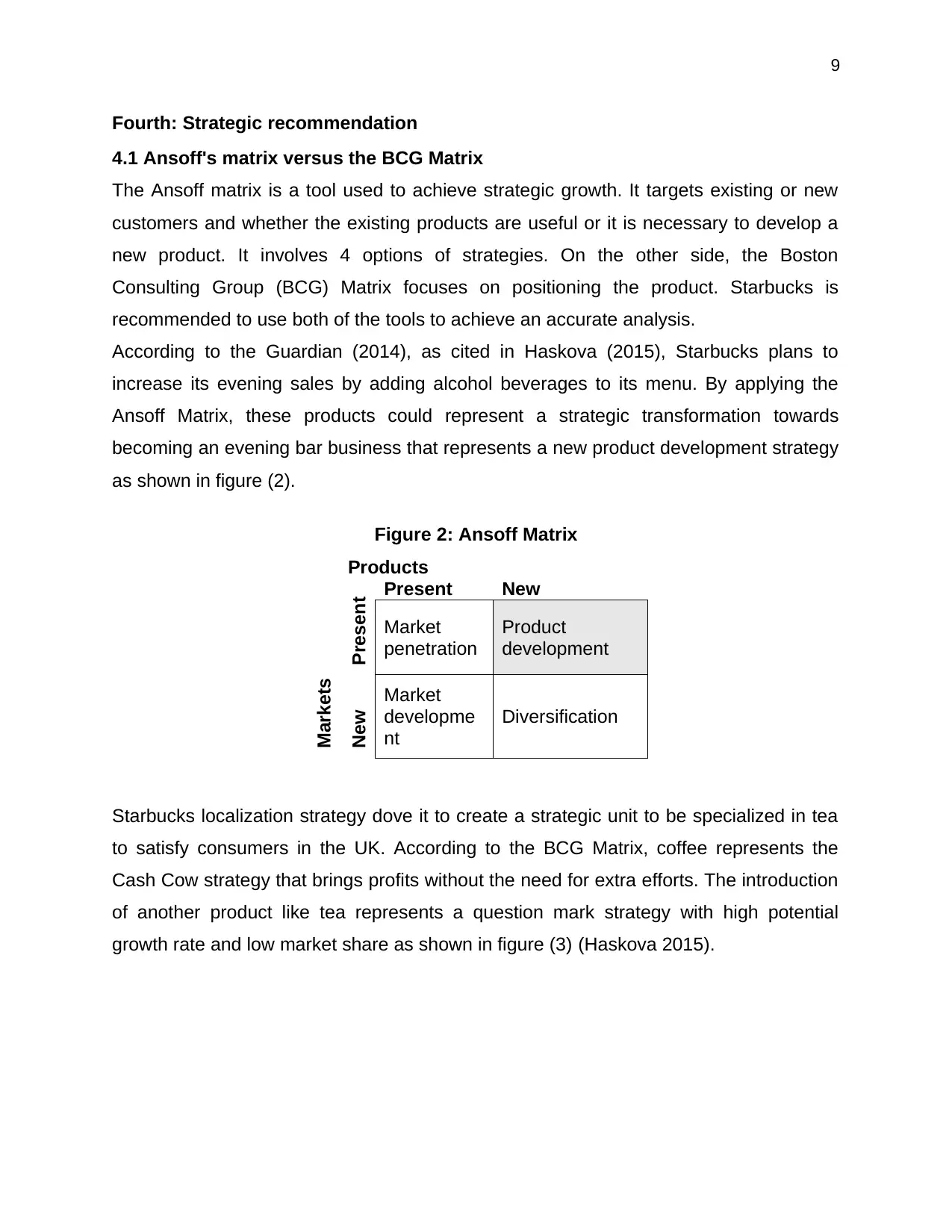
9
Fourth: Strategic recommendation
4.1 Ansoff's matrix versus the BCG Matrix
The Ansoff matrix is a tool used to achieve strategic growth. It targets existing or new
customers and whether the existing products are useful or it is necessary to develop a
new product. It involves 4 options of strategies. On the other side, the Boston
Consulting Group (BCG) Matrix focuses on positioning the product. Starbucks is
recommended to use both of the tools to achieve an accurate analysis.
According to the Guardian (2014), as cited in Haskova (2015), Starbucks plans to
increase its evening sales by adding alcohol beverages to its menu. By applying the
Ansoff Matrix, these products could represent a strategic transformation towards
becoming an evening bar business that represents a new product development strategy
as shown in figure (2).
Figure 2: Ansoff Matrix
Starbucks localization strategy dove it to create a strategic unit to be specialized in tea
to satisfy consumers in the UK. According to the BCG Matrix, coffee represents the
Cash Cow strategy that brings profits without the need for extra efforts. The introduction
of another product like tea represents a question mark strategy with high potential
growth rate and low market share as shown in figure (3) (Haskova 2015).
Markets
Products
Present Present New
Market
penetration
Product
development
New Market
developme
nt
Diversification
Fourth: Strategic recommendation
4.1 Ansoff's matrix versus the BCG Matrix
The Ansoff matrix is a tool used to achieve strategic growth. It targets existing or new
customers and whether the existing products are useful or it is necessary to develop a
new product. It involves 4 options of strategies. On the other side, the Boston
Consulting Group (BCG) Matrix focuses on positioning the product. Starbucks is
recommended to use both of the tools to achieve an accurate analysis.
According to the Guardian (2014), as cited in Haskova (2015), Starbucks plans to
increase its evening sales by adding alcohol beverages to its menu. By applying the
Ansoff Matrix, these products could represent a strategic transformation towards
becoming an evening bar business that represents a new product development strategy
as shown in figure (2).
Figure 2: Ansoff Matrix
Starbucks localization strategy dove it to create a strategic unit to be specialized in tea
to satisfy consumers in the UK. According to the BCG Matrix, coffee represents the
Cash Cow strategy that brings profits without the need for extra efforts. The introduction
of another product like tea represents a question mark strategy with high potential
growth rate and low market share as shown in figure (3) (Haskova 2015).
Markets
Products
Present Present New
Market
penetration
Product
development
New Market
developme
nt
Diversification
Paraphrase This Document
Need a fresh take? Get an instant paraphrase of this document with our AI Paraphraser
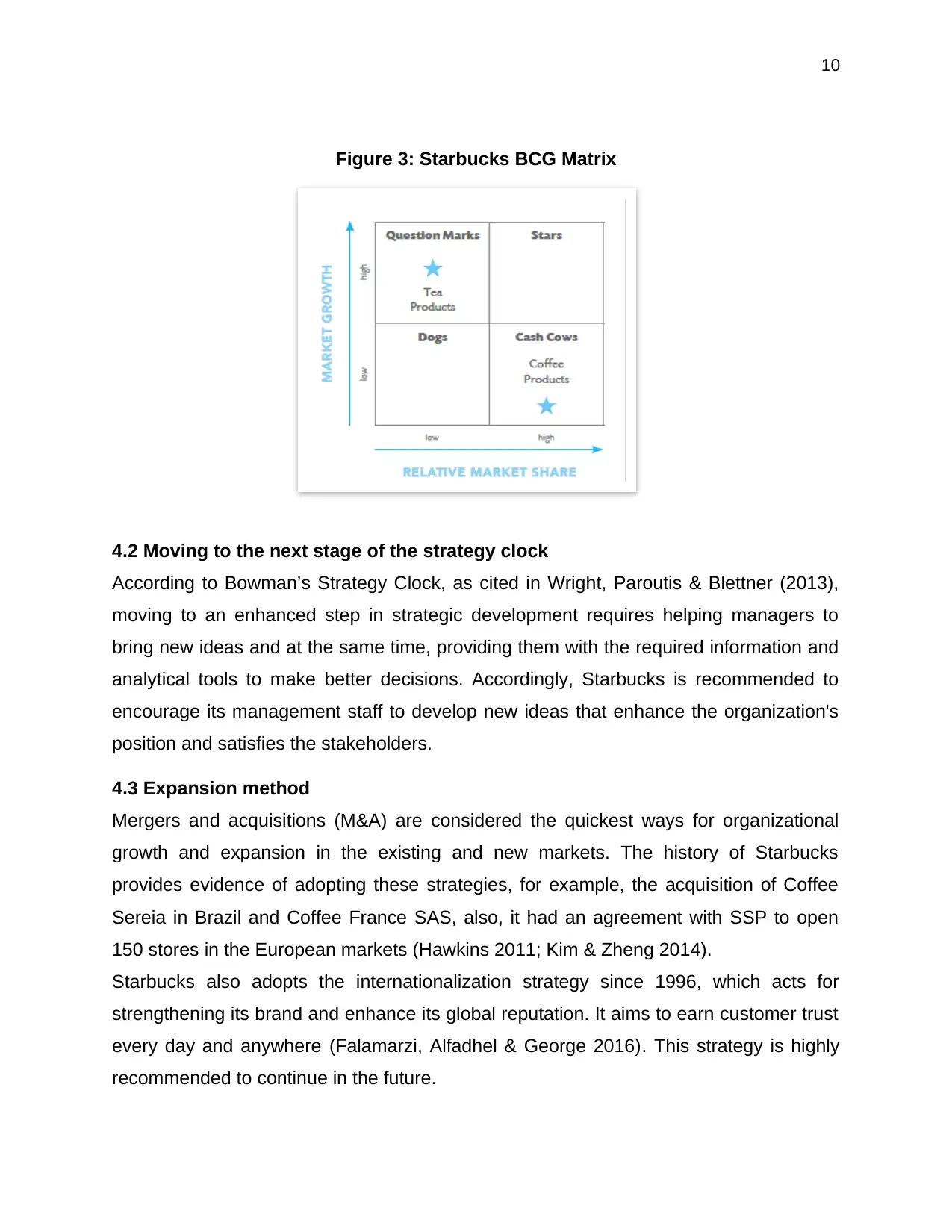
10
Figure 3: Starbucks BCG Matrix
4.2 Moving to the next stage of the strategy clock
According to Bowman’s Strategy Clock, as cited in Wright, Paroutis & Blettner (2013),
moving to an enhanced step in strategic development requires helping managers to
bring new ideas and at the same time, providing them with the required information and
analytical tools to make better decisions. Accordingly, Starbucks is recommended to
encourage its management staff to develop new ideas that enhance the organization's
position and satisfies the stakeholders.
4.3 Expansion method
Mergers and acquisitions (M&A) are considered the quickest ways for organizational
growth and expansion in the existing and new markets. The history of Starbucks
provides evidence of adopting these strategies, for example, the acquisition of Coffee
Sereia in Brazil and Coffee France SAS, also, it had an agreement with SSP to open
150 stores in the European markets (Hawkins 2011; Kim & Zheng 2014).
Starbucks also adopts the internationalization strategy since 1996, which acts for
strengthening its brand and enhance its global reputation. It aims to earn customer trust
every day and anywhere (Falamarzi, Alfadhel & George 2016). This strategy is highly
recommended to continue in the future.
Figure 3: Starbucks BCG Matrix
4.2 Moving to the next stage of the strategy clock
According to Bowman’s Strategy Clock, as cited in Wright, Paroutis & Blettner (2013),
moving to an enhanced step in strategic development requires helping managers to
bring new ideas and at the same time, providing them with the required information and
analytical tools to make better decisions. Accordingly, Starbucks is recommended to
encourage its management staff to develop new ideas that enhance the organization's
position and satisfies the stakeholders.
4.3 Expansion method
Mergers and acquisitions (M&A) are considered the quickest ways for organizational
growth and expansion in the existing and new markets. The history of Starbucks
provides evidence of adopting these strategies, for example, the acquisition of Coffee
Sereia in Brazil and Coffee France SAS, also, it had an agreement with SSP to open
150 stores in the European markets (Hawkins 2011; Kim & Zheng 2014).
Starbucks also adopts the internationalization strategy since 1996, which acts for
strengthening its brand and enhance its global reputation. It aims to earn customer trust
every day and anywhere (Falamarzi, Alfadhel & George 2016). This strategy is highly
recommended to continue in the future.
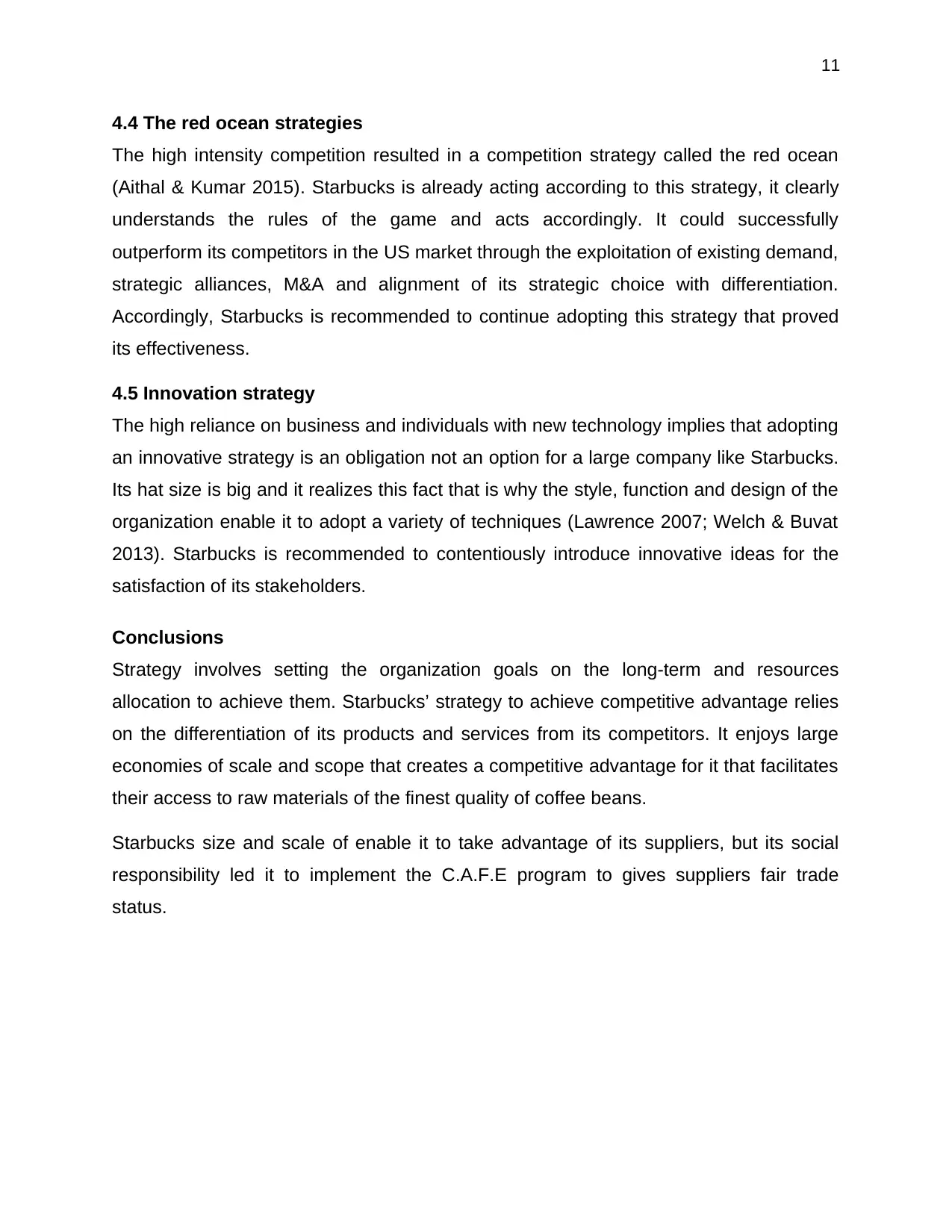
11
4.4 The red ocean strategies
The high intensity competition resulted in a competition strategy called the red ocean
(Aithal & Kumar 2015). Starbucks is already acting according to this strategy, it clearly
understands the rules of the game and acts accordingly. It could successfully
outperform its competitors in the US market through the exploitation of existing demand,
strategic alliances, M&A and alignment of its strategic choice with differentiation.
Accordingly, Starbucks is recommended to continue adopting this strategy that proved
its effectiveness.
4.5 Innovation strategy
The high reliance on business and individuals with new technology implies that adopting
an innovative strategy is an obligation not an option for a large company like Starbucks.
Its hat size is big and it realizes this fact that is why the style, function and design of the
organization enable it to adopt a variety of techniques (Lawrence 2007; Welch & Buvat
2013). Starbucks is recommended to contentiously introduce innovative ideas for the
satisfaction of its stakeholders.
Conclusions
Strategy involves setting the organization goals on the long-term and resources
allocation to achieve them. Starbucks’ strategy to achieve competitive advantage relies
on the differentiation of its products and services from its competitors. It enjoys large
economies of scale and scope that creates a competitive advantage for it that facilitates
their access to raw materials of the finest quality of coffee beans.
Starbucks size and scale of enable it to take advantage of its suppliers, but its social
responsibility led it to implement the C.A.F.E program to gives suppliers fair trade
status.
4.4 The red ocean strategies
The high intensity competition resulted in a competition strategy called the red ocean
(Aithal & Kumar 2015). Starbucks is already acting according to this strategy, it clearly
understands the rules of the game and acts accordingly. It could successfully
outperform its competitors in the US market through the exploitation of existing demand,
strategic alliances, M&A and alignment of its strategic choice with differentiation.
Accordingly, Starbucks is recommended to continue adopting this strategy that proved
its effectiveness.
4.5 Innovation strategy
The high reliance on business and individuals with new technology implies that adopting
an innovative strategy is an obligation not an option for a large company like Starbucks.
Its hat size is big and it realizes this fact that is why the style, function and design of the
organization enable it to adopt a variety of techniques (Lawrence 2007; Welch & Buvat
2013). Starbucks is recommended to contentiously introduce innovative ideas for the
satisfaction of its stakeholders.
Conclusions
Strategy involves setting the organization goals on the long-term and resources
allocation to achieve them. Starbucks’ strategy to achieve competitive advantage relies
on the differentiation of its products and services from its competitors. It enjoys large
economies of scale and scope that creates a competitive advantage for it that facilitates
their access to raw materials of the finest quality of coffee beans.
Starbucks size and scale of enable it to take advantage of its suppliers, but its social
responsibility led it to implement the C.A.F.E program to gives suppliers fair trade
status.
⊘ This is a preview!⊘
Do you want full access?
Subscribe today to unlock all pages.

Trusted by 1+ million students worldwide
1 out of 14
Related Documents
Your All-in-One AI-Powered Toolkit for Academic Success.
+13062052269
info@desklib.com
Available 24*7 on WhatsApp / Email
![[object Object]](/_next/static/media/star-bottom.7253800d.svg)
Unlock your academic potential
Copyright © 2020–2026 A2Z Services. All Rights Reserved. Developed and managed by ZUCOL.





